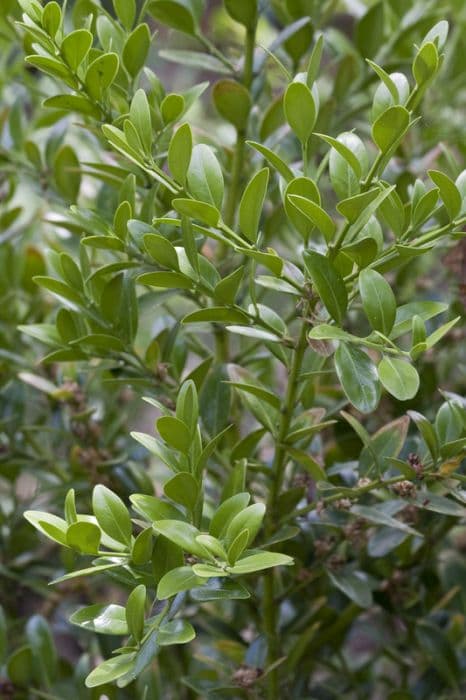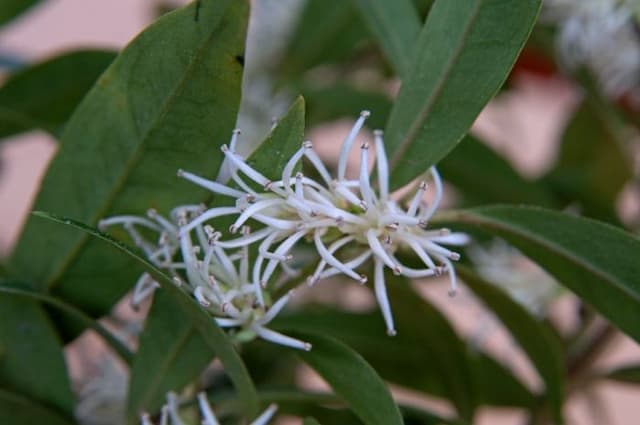Sweetbox Sarcococca trinervia

ABOUT
Sarcococca trinervia, commonly known as Sweet Box, is an evergreen shrub known for its glossy, dark green leaves and fragrant flowers. The plant's leaves are leathery in texture and often have a pointed tip, arranged alternately on the stems. The leaves can appear quite lush, giving the plant a dense and compact overall foliage. The Sweet Box flowers are small, white, and have a creamy texture. They bloom in small clusters and have a sweet, potent fragrance that can be noticed even from a distance. Following the bloom of flowers, it often produces small, glossy, black berries which stand out against the foliage's deep green, creating a striking visual contrast. While this plant is typically noted for its unobtrusive size, the focus here is solely on its aesthetic qualities excluding any dimensional descriptors. Sweet Box has a tidy appearance and is often appreciated for its low-maintenance nature and ability to thrive in shady conditions, which, alongside its fragrant flowers, makes it a popular choice for gardeners looking for all-year-round interest.
About this plant
 Names
NamesFamily
Buxaceae.
Synonyms
Sweet Box, Christmas Box, Sarcococca.
Common names
Sarcococca trinervia.
 Toxicity
ToxicityTo humans
Sarcococca trinervia, commonly known as Sweet Box, is not considered highly toxic to humans. However, like many plants, it may cause mild stomach upset if ingested. While severe toxicity is rare, it's prudent to avoid consuming any part of the Sweet Box plant. If ingested, symptoms could include nausea, vomiting, and diarrhea. In the case of accidental ingestion or if symptoms persist, seek medical advice.
To pets
Sweet Box, or Sarcococca trinervia, may not be highly toxic to pets, but it can cause mild gastrointestinal upset if ingested. Symptoms of Sweet Box poisoning in pets could include vomiting, diarrhea, and abdominal pain. Although these symptoms are generally not severe, it is advisable to prevent pets from eating any part of the Sweet Box plant. If your pet does ingest it and displays symptoms, consult your veterinarian for guidance.
 Characteristics
CharacteristicsLife cycle
Perennials
Foliage type
Evergreen
Color of leaves
Green
Flower color
White
Height
2-3 feet (60-90 cm)
Spread
2-3 feet (60-90 cm)
Plant type
Shrub
Hardiness zones
7
Native area
Himalayas
Benefits
 General Benefits
General Benefits- Aesthetic Appeal - Adds evergreen foliage and visual interest to gardens and landscapes throughout the year.
- Fragrance - The plant’s small but highly fragrant flowers can add a pleasant scent to the area where it is planted.
- Low Maintenance - Typically requires minimal care once established, making it a good choice for gardeners of all skill levels.
- Shade Tolerance - Capable of growing in shaded areas where other plants may struggle, providing greenery in less sunny spots.
- Wildlife Attraction - Its flowers can attract pollinators such as bees, while its berries can provide food for birds.
 Medical Properties
Medical PropertiesThis plant is not used for medical purposes.
 Air-purifying Qualities
Air-purifying QualitiesThis plant is not specifically known for air purifying qualities.
 Other Uses
Other Uses- Sweet Box wood can be used in the creation of small decorative items, such as inlays for intricate woodworking projects, due to its fine texture and ease of manipulation.
- Due to its dense foliage, Sweet Box can serve as a privacy screen when planted in a series along property boundaries.
- The fragrant flowers of Sweet Box are sometimes used in potpourri mixtures to add a pleasant aroma to indoor environments.
- Sweet Box is suitable for creating low hedges in formal garden designs, providing structure and greenery throughout the year.
- When dried, the branches of Sweet Box can be used in floral arrangements to add greenery and structure.
- The plant's ability to thrive in shade makes it an ideal ground cover under tree canopies where other plants might struggle to grow.
- Sweet Box is utilised in slope stabilization and erosion control due to its extensive root system that helps hold soil in place.
- Landscape designers often use Sweet Box in sensory gardens, where its fragrance enhances the sensory experience.
- In larger gardens, Sweet Box can be planted as an evergreen backdrop to showcase seasonal flowers or other garden features.
- Sweet Box is sometimes used in container gardens, especially in areas with limited space, due to its compact growth habit.
Interesting Facts
 Feng Shui
Feng ShuiThe Sweet Box is not used in Feng Shui practice.
 Zodiac Sign Compitability
Zodiac Sign CompitabilityThe Sweet Box is not used in astrology practice.
 Plant Symbolism
Plant Symbolism- Protection: Sarcococca trinervia, also known as Sweet Box, is believed to provide protective energies, perhaps due to its evergreen nature which symbolizes constancy and resilience.
- Purity: The sweet, pure scent of its flowers, which bloom even in the depths of winter, may contribute to its symbolism of purity and cleanliness.
- Hope: Blooming in the cold winter months, Sweet Box represents hope and the promise of spring and renewal.
- Consolation: Its ability to thrive in the shade can symbolize consolation, offering a bright spot in dark times.
 Water
WaterSarcococca, commonly known as Sweet Box, prefers to be kept consistently moist but not waterlogged. Water the plant thoroughly when the top inch of soil feels dry to the touch, which typically means once a week, depending on the environmental conditions. During active growth in the spring and summer, it may need more frequent watering. Aim to provide the Sweet Box with about 1 gallon of water each time you water it, adjusting based on the plant's size and the weather. In the fall and winter, reduce watering to every other week, ensuring that soil doesn't become too dry
 Light
LightSweet Box thrives best in partial to full shade conditions, making it ideal for spots that receive filtered sunlight or dappled shade. Avoid placing it in direct, intense sunlight as it can scorch the leaves. A north-facing spot that gets some morning light or a shaded area under a tree with bright, indirect light would be perfect for the Sweet Box
 Temperature
TemperatureSweet Box is hardy and can tolerate a range of temperatures, from a minimum of about 10 degrees Fahrenheit in the winter to a maximum of around 80 degrees Fahrenheit in the summer. However, it thrives in cooler temperate zones with an ideal temperature range between 60 to 70 degrees Fahrenheit. It's important to protect the plant from extreme cold and hot temperatures to prevent damage
 Pruning
PruningPruning of Sweet Box is generally done to maintain its shape or remove any dead or diseased wood. It is best pruned after flowering, which typically occurs in late winter or early spring. Pruning can be done annually, though the plant tolerates cutting back quite well if more drastic shaping is needed. Remove any crossing branches and thin out crowded areas to ensure good air circulation and light penetration throughout the plant
 Cleaning
CleaningAs needed
 Soil
SoilSweet Box prefers a well-draining, humus-rich soil mix with an acidic to neutral pH between 5.5 and 7. A good mixture might include garden soil, compost, and perlite or pine bark fines to ensure proper drainage and aeration for the roots.
 Repotting
RepottingSweet Box typically requires repotting every 2-3 years to refresh the soil and allow for growth. It's best to repot in the spring before new growth starts.
 Humidity & Misting
Humidity & MistingSweet Box thrives in moderate to high humidity environments but is quite adaptable and can tolerate lower humidity levels found in most home settings.
 Suitable locations
Suitable locationsIndoor
Place Sweet Box in bright, indirect light with moist soil.
Outdoor
Plant in shaded area with moist, well-draining soil.
Hardiness zone
7-9 USDA
 Life cycle
Life cycleSarcococca trinervia, also known as Sweetbox, begins its life cycle when seeds germinate in moist, shady conditions, typically in spring. The seedlings develop into young plants with a robust root system and glossy evergreen leaves. As the plants mature, they form dense clumps and produce small, fragrant white flowers, usually in late winter or early spring. Following pollination, often by insects attracted to the scent, the flowers give way to shiny black berries. These berries are eaten by birds, which help in seed dispersal. Sweetbox is a perennial shrub, so once it reaches maturity, it will go through a cycle of flowering and fruiting annually for many years, often with little need for intervention.
 Propogation
PropogationPropogation time
Late winter to early spring
Sarcococca trinervia, commonly known as Sweet Box, is most effectively propagated through semi-ripe cuttings. This method involves taking cuttings from the current year's growth, typically in late summer. The cuttings should be about 4 to 6 inches (10 to 15 centimeters) in length, with the lower leaves removed. The base of the cutting is often dipped in rooting hormone powder to encourage root development. These prepared cuttings are then inserted into a pot filled with a mix of perlite and peat, ensuring that the leaf nodes are buried where roots will form. The pot should be placed in a warm environment with indirect light and kept moist. It usually takes several weeks for rooting to occur, after which the new Sweet Box plants can gradually acclimate to outdoor conditions before being transplanted into the garden.








![Sweet box [Winter Gem]](/_next/image?url=https%3A%2F%2Fplants-admin.emdemapps.com%2Fimages%2Fplants%2F%2Fimages%2F604b6267b442c.png&w=640&q=75)
